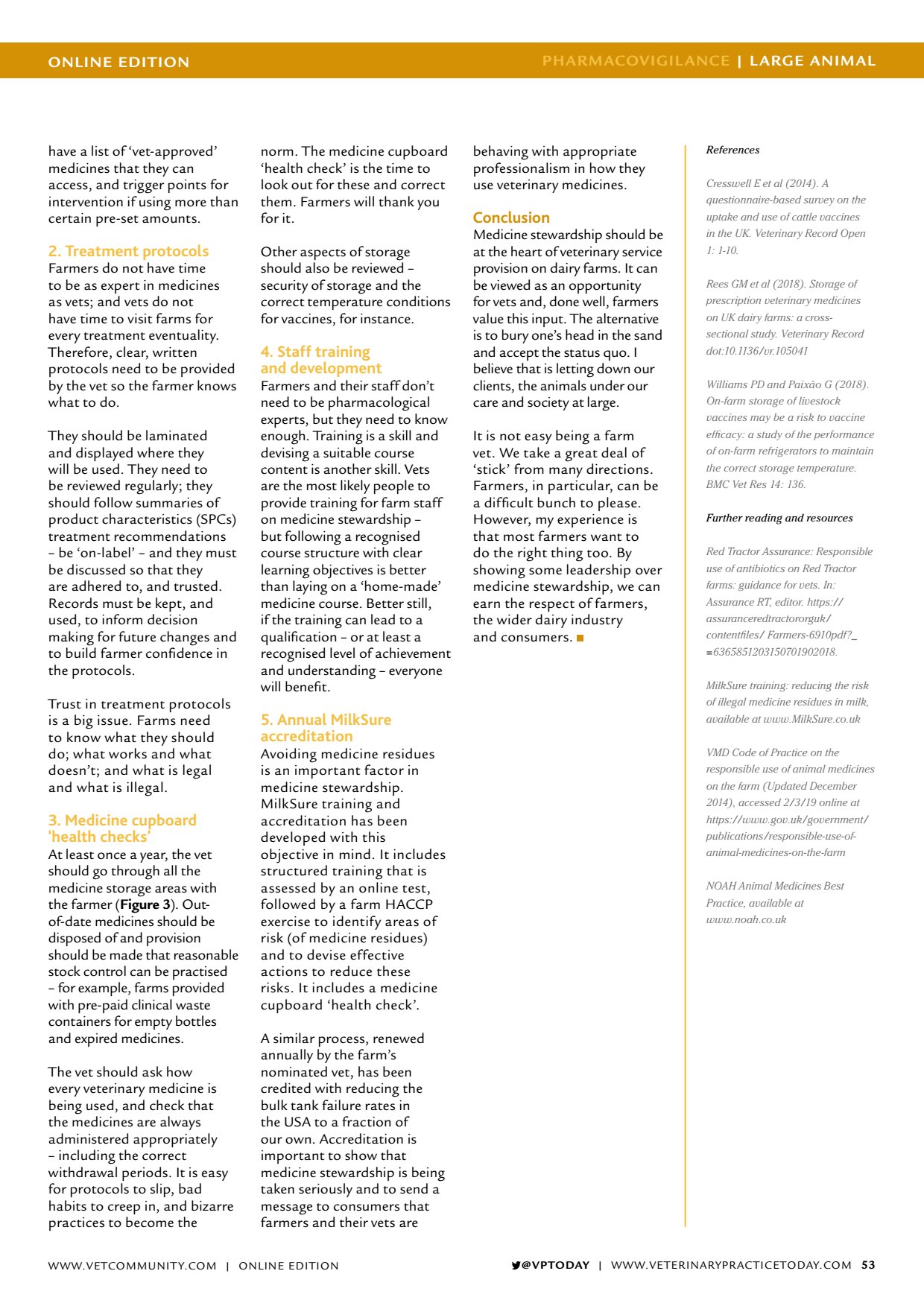Treatment protocols Medicine
ONLINE EDITION PHARMACOVIGIL ANCE | L ARGE ANIMAL VPTODAY | WWW.VETERINARYPRACTICETODAY.COM 53 have a list of vet-approved medicines that they can access, and trigger points for intervention if using more than certain pre-set amounts. 2. Treatment protocols Farmers do not have time to be as expert in medicines as vets; and vets do not have time to visit farms for every treatment eventuality. Therefore, clear, written protocols need to be provided by the vet so the farmer knows what to do. They should be laminated and displayed where they will be used. They need to be reviewed regularly; they should follow summaries of product characteristics (SPCs) treatment recommendations be on-label and they must be discussed so that they are adhered to, and trusted. Records must be kept, and used, to inform decision making for future changes and to build farmer confidence in the protocols. Trust in treatment protocols is a big issue. Farms need to know what they should do; what works and what doesnt; and what is legal and what is illegal. 3. Medicine cupboard health checks At least once a year, the vet should go through all the medicine storage areas with the farmer ( Figure 3 ). Out- of-date medicines should be disposed of and provision should be made that reasonable stock control can be practised for example, farms provided with pre-paid clinical waste containers for empty bottles and expired medicines. The vet should ask how every veterinary medicine is being used, and check that the medicines are always administered appropriately including the correct withdrawal periods. It is easy for protocols to slip, bad habits to creep in, and bizarre practices to become the norm. The medicine cupboard health check is the time to look out for these and correct them. Farmers will thank you for it. Other aspects of storage should also be reviewed security of storage and the correct temperature conditions for vaccines, for instance. 4. Staff training and development Farmers and their staff dont need to be pharmacological experts, but they need to know enough. Training is a skill and devising a suitable course content is another skill. Vets are the most likely people to provide training for farm staff on medicine stewardship but following a recognised course structure with clear learning objectives is better than laying on a home-made medicine course. Better still, if the training can lead to a qualification or at least a recognised level of achievement and understanding everyone will benefit. 5. Annual MilkSure accreditation Avoiding medicine residues is an important factor in medicine stewardship. MilkSure training and accreditation has been developed with this objective in mind. It includes structured training that is assessed by an online test, followed by a farm HACCP exercise to identify areas of risk (of medicine residues) and to devise effective actions to reduce these risks. It includes a medicine cupboard health check. A similar process, renewed annually by the farms nominated vet, has been credited with reducing the bulk tank failure rates in the USA to a fraction of our own. Accreditation is important to show that medicine stewardship is being taken seriously and to send a message to consumers that farmers and their vets are References Cresswell E et al (2014). A questionnaire-based survey on the uptake and use of cattle vaccines in the UK. Veterinary Record Open 1: 1-10. Rees GM et al (2018). Storage of prescription veterinary medicines on UK dairy farms: a cross- sectional study. Veterinary Record dot:10.1136/vr.105041 Williams PD and Paixão G (2018). On-farm storage of livestock vaccines may be a risk to vaccine efficacy: a study of the performance of on-farm refrigerators to maintain the correct storage temperature. BMC Vet Res 14: 136. Further reading and resources Red Tractor Assurance: Responsible use of antibiotics on Red Tractor farms: guidance for vets. In: Assurance RT, editor. https:// assuranceredtractororguk/ contentfiles/ Farmers-6910pdf?_ =6365851203150701902018. MilkSure training: reducing the risk of illegal medicine residues in milk, available at www.MilkSure.co.uk VMD Code of Practice on the responsible use of animal medicines on the farm (Updated December 2014), accessed 2/3/19 online at https://www.gov.uk/government/ publications/responsible-use-of- animal-medicines-on-the-farm NOAH Animal Medicines Best Practice, available at www.noah.co.uk behaving with appropriate professionalism in how they use veterinary medicines. Conclusion Medicine stewardship should be at the heart of veterinary service provision on dairy farms. It can be viewed as an opportunity for vets and, done well, farmers value this input. The alternative is to bury ones head in the sand and accept the status quo. I believe that is letting down our clients, the animals under our care and society at large. It is not easy being a farm vet. We take a great deal of stick from many directions. Farmers, in particular, can be a difficult bunch to please. However, my experience is that most farmers want to do the right thing too. By showing some leadership over medicine stewardship, we can earn the respect of farmers, the wider dairy industry and consumers. WWW.VETCOMMUNIT Y.COM | ONLINE EDITION
